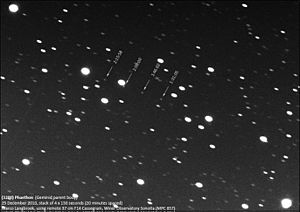3200 Phaethon facts for kids

Asteroid (3200) Phaethon imaged on 25 Dec 2010 with the 37 cm F14 Cassegrain telescope of Winer Observatory, Sonoita (MPC 857) by Marco Langbroek.
|
|
| Discovery | |
|---|---|
| Discovery date | 11 October 1983 |
| Designations | |
|
Named after
|
Phaëton |
| 1983 TB | |
| Apollo asteroid | |
| Orbital characteristics | |
| Epoch July 14, 2004 (JD 2453200.5) | |
| Aphelion | 2.403 AU (359.456 Gm) |
| Perihelion | 0.140 AU (20.922 Gm) |
| 1.271 AU (190.189 Gm) | |
| Eccentricity | 0.890 |
| 1.43 a (523.586 d) | |
|
Average orbital speed
|
19.98 km/s |
| 200.798° | |
| Inclination | 22.169° |
| Physical characteristics | |
| Dimensions | 5.1 km |
| Mass | 1.4×1014 kg |
3200 Phaethon is a special space rock that acts like both an asteroid and a comet. Scientists sometimes call it a "dead comet." It's unique because it was the first asteroid ever found using a spacecraft. Phaethon is about 5.1 kilometers (about 3.2 miles) wide.
It was first announced on October 14, 1983. Later, telescopes confirmed that it looked like an asteroid.
Contents
Phaethon's Journey Around the Sun
Phaethon gets closer to the Sun than any other numbered asteroid. Its closest point to the Sun is called its perihelion. This point is only 0.140 AU away from the Sun. To give you an idea, that's less than half the distance of Mercury's closest approach to the Sun!
Because of its path, Phaethon crosses the orbits of several planets. It is a Mercury-, Venus-, Earth-, and Mars-crosser.
Why Is It Named Phaethon?
When Phaethon gets so close to the Sun, its surface can get extremely hot. The temperature can reach about 1025 Kelvin, which is around 1400 degrees Fahrenheit!
Because of this intense heat, it was named after a character from Greek mythology. In the myth, Phaëton was the son of the sun god Helios. Phaethon tried to drive his father's sun chariot but lost control, causing great heat on Earth.
Close Encounters with Earth
Phaethon sometimes comes quite close to Earth. On December 10, 2007, it passed within 18.1 million kilometers of our planet.
It will have more close approaches in the future. It will come nearer in the years 2017, 2050, and 2060. An even closer pass is expected on December 14, 2093. On that date, it will pass within 0.0198 AU (about 3 million kilometers) of Earth.
Images for kids
See also
 In Spanish: (3200) Faetón para niños
In Spanish: (3200) Faetón para niños




